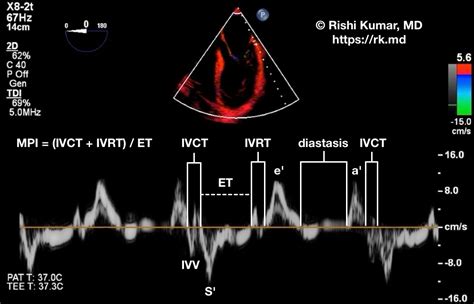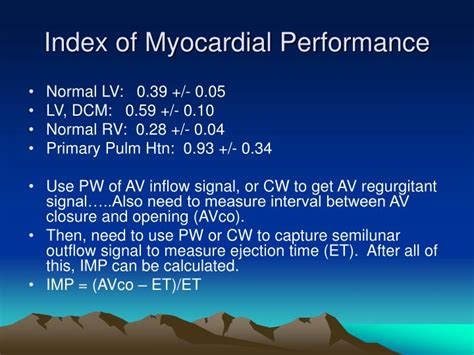lv mpi | Left ventricular myocardial performance index for assessment of lv mpi The Myocardial Performance Index (MPI), also known as the Tei Index, assesses global myocardial function through systolic and diastolic performance of the right and left ventricle. LV can be harder to find than Dex-VI. Both specs are great long life low Vis fluids. I wouldn't claim them as interchangeable, however I believe they are more similar than different and could be interchanged if need be.
0 · Stress Myocardial Perfusion Imaging for Assessing Prognosis: An
1 · Myocardial performance index, a Doppler
2 · Myocardial performance index as an echocardiographic
3 · Myocardial Performance Index (Tei Index): A simple tool to
4 · Myocardial Performance Index (Tei Index) Calculator
5 · Left ventricular myocardial performance index for assessment of
6 · Fetal left ventricular myocardial performance index: Defining
7 · Fetal left and right ventricle myocardial performance index:
8 · Fetal Cardiac Function: Myocardial Performance Index
9 · Clinical value of myocardial performance index in patients with
Features and Design This Multimedia Projector is designed with the most advanced technology for portability, durability, and ease of use. This projector utilizes built-in multimedia features, a palette of 16.77 million colors, and matrix liquid crystal display (LCD) technology. control or remote controller (p.55).

Stress Myocardial Perfusion Imaging for Assessing Prognosis: An
The Myocardial Performance Index (MPI), also known as the Tei Index, assesses global myocardial function through systolic and diastolic performance of the right and left ventricle.Cardiac dysfunction is the major cause of morbidity and mortality in diabetes. Myocardial Performance Index (MPI/Tei Index) includes both systolic and diastolic time intervals to assess . The Doppler-derived myocardial performance index (MPI) has been considered as a diagnostic and prognostic Doppler marker for many different clinical conditions.The Myocardial Performance Index (MPI) or Tei index, presented by Tei in 1995, is the ratio of the sum of the duration of the isovolumetric contraction time (ICT) and isovolumetric relaxation .
Transient ischemic left ventricular (LV) cavity dilation was another high-risk variable that was associated with an adverse outcome. Transient ischemic dilation (TID) in most .LV and RV MPI values were independent of GA and fetal heart rate. MPI is a useful parameter for the assessment of global cardiac function in the fetus and demonstrates good reproducibility . The LV MPI was calculated as (isovolumic contraction time “ICT” + relaxation time “IRT”)/Ejection time “ET”. Besides, clinical and echocardiographic variables were analyzed and .
Conventional MPI is a precise clinical tool for assessing combined systolic, diastolic and regional function of LV myocardium. LV MPI increases proportionally with increase in .The aim of this study was to determine normal values for fetal left ventricular (LV)-myocardial performance index (MPI) in Indian population and to assess its relation to advancing gestation .The Myocardial Performance Index (MPI), also known as the Tei Index, assesses global myocardial function through systolic and diastolic performance of the right and left ventricle.Cardiac dysfunction is the major cause of morbidity and mortality in diabetes. Myocardial Performance Index (MPI/Tei Index) includes both systolic and diastolic time intervals to assess the global cardiac dysfunction. Our aim was to assess the MPI in patients with type 2 diabetes.
Myocardial performance index (MPI, also denoted TEI-Doppler index) reflects both left ventricular (LV) systolic and diastolic function. Methods and results. The Doppler-derived myocardial performance index (MPI) has been considered as a diagnostic and prognostic Doppler marker for many different clinical conditions.The Myocardial Performance Index (MPI) or Tei index, presented by Tei in 1995, is the ratio of the sum of the duration of the isovolumetric contraction time (ICT) and isovolumetric relaxation time (IRT) to the duration of the ejection time (ET).
Transient ischemic left ventricular (LV) cavity dilation was another high-risk variable that was associated with an adverse outcome. Transient ischemic dilation (TID) in most patients is due to extensive subendocardial ischemia post-stress that resolves on the resting scan.LV and RV MPI values were independent of GA and fetal heart rate. MPI is a useful parameter for the assessment of global cardiac function in the fetus and demonstrates good reproducibility with narrow interobserver and intraobserver variability.
The LV MPI was calculated as (isovolumic contraction time “ICT” + relaxation time “IRT”)/Ejection time “ET”. Besides, clinical and echocardiographic variables were analyzed and CHF was defined as Killip class ≥ II. Results. Early in-hospital HF occurred in .
Conventional MPI is a precise clinical tool for assessing combined systolic, diastolic and regional function of LV myocardium. LV MPI increases proportionally with increase in severity of CAD. MPI derived on day 1 after PCI, reflects the success of revascularization and myocardial functional recovery after intervention.

The aim of this study was to determine normal values for fetal left ventricular (LV)-myocardial performance index (MPI) in Indian population and to assess its relation to advancing gestation and fetal heart rate (FHR).
The Myocardial Performance Index (MPI), also known as the Tei Index, assesses global myocardial function through systolic and diastolic performance of the right and left ventricle.Cardiac dysfunction is the major cause of morbidity and mortality in diabetes. Myocardial Performance Index (MPI/Tei Index) includes both systolic and diastolic time intervals to assess the global cardiac dysfunction. Our aim was to assess the MPI in patients with type 2 diabetes. Myocardial performance index (MPI, also denoted TEI-Doppler index) reflects both left ventricular (LV) systolic and diastolic function. Methods and results. The Doppler-derived myocardial performance index (MPI) has been considered as a diagnostic and prognostic Doppler marker for many different clinical conditions.
The Myocardial Performance Index (MPI) or Tei index, presented by Tei in 1995, is the ratio of the sum of the duration of the isovolumetric contraction time (ICT) and isovolumetric relaxation time (IRT) to the duration of the ejection time (ET).
Myocardial performance index, a Doppler
Transient ischemic left ventricular (LV) cavity dilation was another high-risk variable that was associated with an adverse outcome. Transient ischemic dilation (TID) in most patients is due to extensive subendocardial ischemia post-stress that resolves on the resting scan.LV and RV MPI values were independent of GA and fetal heart rate. MPI is a useful parameter for the assessment of global cardiac function in the fetus and demonstrates good reproducibility with narrow interobserver and intraobserver variability.
The LV MPI was calculated as (isovolumic contraction time “ICT” + relaxation time “IRT”)/Ejection time “ET”. Besides, clinical and echocardiographic variables were analyzed and CHF was defined as Killip class ≥ II. Results. Early in-hospital HF occurred in . Conventional MPI is a precise clinical tool for assessing combined systolic, diastolic and regional function of LV myocardium. LV MPI increases proportionally with increase in severity of CAD. MPI derived on day 1 after PCI, reflects the success of revascularization and myocardial functional recovery after intervention.

burberry body perfume buy online
Check your order, save products & fast registration all with a Canon Account
lv mpi|Left ventricular myocardial performance index for assessment of


























